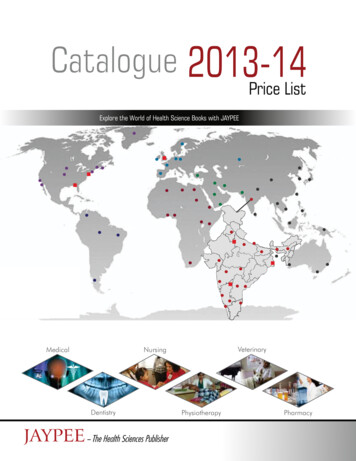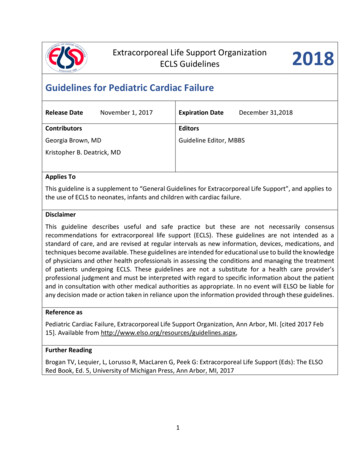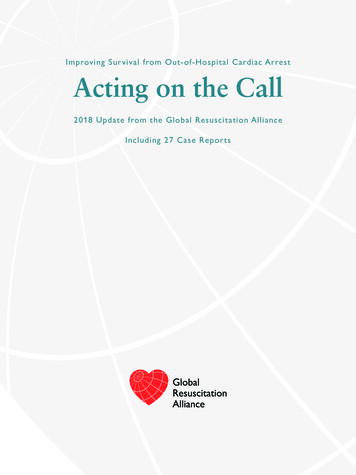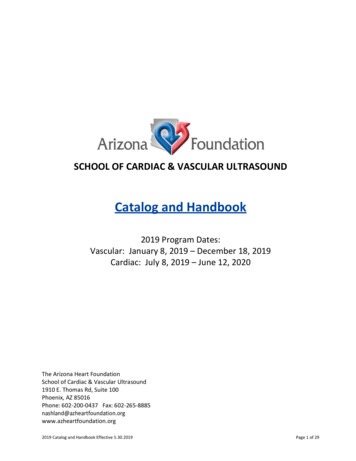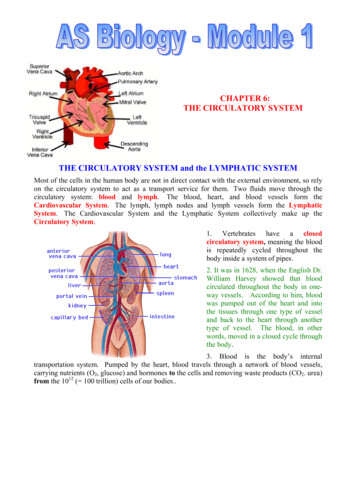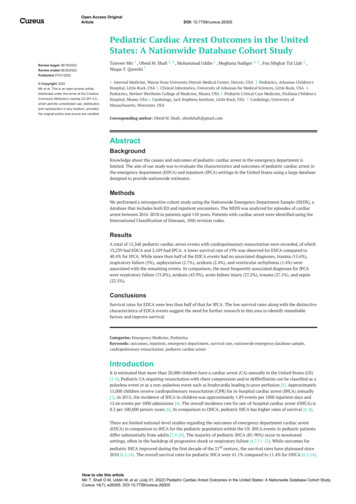
Transcription
Cardiac Surgery Made Ridiculously Simpleby Art Wallace, M.D., Ph.D.Cardiac surgery is a dangerous and complex field of medicine with significant morbidity and mortality.Quality anesthetic care with specific attention to detail can greatly enhance patient safety and outcome.Details that are ignored can lead to disaster. This document will attempt to describe the bare bonessequence for cardiac anesthesia for adult CABG and VALVE procedures with specific recommendations.It is not all inclusive or definitive but it is the minimal critical requirements.If you keep your head screwed on very tightly and pay 100% attention at all times, things will only gopoorly some of the time.A good reference is: Cardiac Surgery in the Adult by L. Henry Edmunds, Jr., MD which is available onlinehttp://www.ctsnet.org/book/An online reference text “Cardiothoracic Surgery Notes” for residents is available athttp://www.ctsnet.org/residents/ctsn/An online Johns Hopkins Cardiac Intern Survival Guide is available at http://www.ctsnet.org/doc/2695Attendings:Mark Ratcliffe, M.D. Elaine Tseng, M.D.Rounds:M, T, W, Th, Fri, Sat, SunFellow: Ted Wright, M.D.Conference:Thursday 12:30 QI Meeting 203-3B-66Friday 6:00 RoundsFriday 7:00 Case Discussion 1C-Teak RoomTuesday 4:30 Cath Conference: 1A-62Thursday 1:30 Chest Conference MRI Conference Room Basement by MRI.Clinic:Thursday 9-12:30General Rules:1. Call fellow whenever in doubt.2. If you don’t know, ask.3. Never start or stop an inotrope infusion, without asking the fellow.4. Do not transfuse blood products, without asking the fellow.5. If a patient arrests start ACLS, and call the fellow.6. Do not let a cardiac patient die with their chest closed.7. Don't forget your ABC's.8. In a code ELECTRICITY is your friend.9. V-tach unstable or V-fib SHOCK-SHOCK-SHOCK epinephrine 1 mg, amiodarone 150 mg, lidocaine 100 mg,CPR repeat.10. A-fib is common, rarely requires shock.11. If the Fellow does not call you back, call the attending on-call.12. When things get tough, or you can not get the SCUT done, ask for help,13. I was too busy- is not the right answer.
14. All patients going to the operating room must have a CARDIOTHORACIC PREOPERATIVE CHECKLISTnote filled out the night before surgery. If you don't fill out the note, the patient can't go to the OR. No checklist,no operation.15. All patients going to the operating room must have either a fellows or an attending note prior to going to theOR. No note, no operation.16. All patients must have a mark on their operative site. No mark, no operation.17. All patients must have a consent that lists their operation, No consent, no operation.ASSUME nothing: Assuming things makes an ASS out U and ME.There are two kinds of interns, those who write things down, and those who forget.Intern on call must:1. Call consults early2. Discharge patients early3. Transfer patients from ICU4. Check all labsCheck PathologyCheck all new culturesTake appropriate action on abnormal labs.5. Keep the Coumadin sheet up to date.7. Take all calls. If you are called, go see the patient.8. See the consults write a note and make a copy so that Staff can dictate a note9. Keep the 3X5 cards up to date.10. Make a good scut list and get everything done on that list.11. Do not let the post-call intern go home until you are certain you can do all the work on the scut-list, callfellow if this is past noon.12. If there is a systematic problem with the service, ie order sets are wrong, this document is out of date, clinicalpathway is out of date,notify the fellow and/or service chief to correct the mistake.13. At the end of your rotation, the service chief will ask for a summary of the problems with the service. If thereis a problem, notify theservice chief so that it can be corrected. Thanks.14. All patients going to the operating room must have a CARDIOTHORACIC PREOPERATIVE CHECKLISTnote filled out the night before surgery. If you don't fill out the note, the patient can't go to the OR. No checklist,no operation.15. All patients going to the operating room must have either a fellows or an attending note prior to going to theOR. No note, no operation.16. All patients must have a mark on their operative site. No mark, no operation.17. All patients must have a consent that lists their operation, No consent, no operation.Preoperative Evaluation:Patient Examination:Pre-surgical evaluation must include attention to cardiac history. The cath report, thallium, echo, andECG. Critical information includes: Left main disease or equivalent, poor distal targets, ejection fraction,
LVEDP, presence of aneurysm, pulmonary hypertension, valvular lesions, congenital lesions. Pastsurgical history is critical as well. Have they had surgery on a leg which may compromise the availabilityof vein graft harvest. Have they had vascular surgery in the groin that will make balloon pump placementdifficult? Each of these points requires a modification of surgical technique and specific information isrequired. How is their angina manifest? You need to be able to understand their verbal reports. If apatient's angina is experienced as shortness of breath, or nausea, or heart burn, or whatever, you need tobe able to link that symptom to possible myocardial ischemia.Past medical history including history of COPD, TIA, stroke, cerebral vascular disease, renal disease(CRI is an independent risk factor), hepatic insufficiency will change anesthetic management.Past surgical history: Every operation they have had. If they have had surgery on a leg they needultrasonic vein mapping.Allergies:Medications : Look specifically for anti-anginal regimen - synergism between calcium channel and betablockers, is their COPD being treated? It is very important for patients to stay on their anti-anginaltherapy throughout the hospital stay. If a patient is on a beta blocker, calcium channel blocker, nitrate,and/or ACE inhibitor they should remain on that drug throughout the perioperative period. The patientshould get all anti-anginal medications on the day of surgery and following surgery. The day of surgery isthe wrong time to go through a withdrawal process on any anti-anginal drug. Withdrawing a single antianginal drug during the perioperative period is associated with a 3 to 5 times increased risk of MI, Stroke,renal failure, and/or death.Physical exam: What was that scar from? Do they have leg veins for grafts? Are they going to have a GIbleed?Chest: Is the patient in failure? Pneumonia? COPDCardiac: Do they have a murmur? Are they in failure?Abd: Ascities, ObesityLABS: Minimal CBC, Plt, Lytes, BUN, CR, Glu, PT,PTTCXR: Cardiomegaly? Tumors? Pleural effusions?ECG: LBBB: Critical information if a pulmonary artery catheter is planned. Occasionally patients withLBBB can develop third degree block withPA catheter placement.Have they had a recent MI? Do they have resting ischemia? Where are their ST-T changes?PFT and ABG: Are they going to become a respiratory cripple? All patients for cardiac surgery needPFT's (FEV1 and FVC) for risk stratification. All patients for thoracic surgery need PFT's to decide if andwhat can be resected.Information: Tell them about the A-line, the PA catheter, and post op ventilation.Consent: Patients having cardiac surgery have serious and frequent complications including: MI 6%,CVA 5%, Neuropsychiatric Effects 90%, Death 1-3-10% (Depends on risk), Transfusion (40-90%),Pneumonia 10%. You must discuss these risks. Copy the consent and have it scanned into the computer.
Loss of the consent form delays surgery by at least 30 minutes.Note: Write a clear note with all the standard details and consent. With the computerized records it is easyto get all the patient's information. If you copy someone else's note, check all the details with the patient.Notes should accumulate all past information, check it for accuracy, and describe what you are going todo. If you don't check it, it will be wrong. Make sure you sign your note so that it is visible to othercomputer users.Night Before Surgery:1. All elective patients must have a note on the night prior to surgery by the attending or fellowspecifying the preoperative condition of the patient and the surgical plan. If the note is written by thefellow, the attending doing the operation must be specified, the plan must have been discussed andapproved by that attending, and the attending must agree with the plan. The attending doing the case mustreview the cath films prior to this note being written.2. The house staff must fill out the CARDIOTHORACIC PREOPERATIVE CHECKLIST the nightbefore surgery. All problems must be resolved prior to the morning of surgery. If you don't fill out thenote, the patient can't go to the OR. No checklist, no operation.3. All work up on patients scheduled for the following day should be completed, if possible, by 5 pm. It isbest to have it all completed by noon. If there is a problem, another case can be placed in the slot. If thework up is delayed, then the slot is lost.Preoperative Testing:1. Work Up: What tests are needed in each patient.PFT: All patients for cardiac or thoracic surgery need PFT's. These tests are for required by the VAMCfor risk stratification. If the patient is scheduled for CABG, you need FEV1 and FVC. If they have ahistory of severe COPD (FEV1 1.5 or 50% of expected, on MDI steroids, morbid obesity, sleep apnea,or CO2 retainer) they also need a blood gas. If they are for thoracic surgery they need a blood gas.Patients should get pulmonary function testing in the pulmonary function lab if possible. Bed side PFT'sshould not be obtained unless the patient is in the ICU on multiple infusions. If the patient can not sit upor they are intubated, do not request the test. Spirometry can be obtained from the pulmonary functiontest on a drop in basis by calling 2415.V/Q Scan: Any patient for lobectomy with FEV1 1.5 liters, any patient for pneumonectomy with FEV1 2.0 liters.PT/PTT If the patient has a coagulopathy preoperatively consider hematology consult. Patients with priorpulmonary embolus, unexplained embolism, bleeding diathesis, hemophilia, get a consult. If a patient is aJehovah's Witness, the should be treated with iron and erythropoietin until their hematocrit is 48.Jehovah's Witnesses may not receive asprin (any dose), NSAIDS, or platelet inhibitors (plavix) for 10days prior to surgery. They should all receive intraoperative aprotinin.Urine: If the patient has a positive leucocyte esterase or WBC in urine greater than 5 repeat the U/A withgood technique and culture it. If they have symptoms of a urinary tract infection (fever, tenderness topercussion, elevated WBC) they should not have elective surgery. If they do not have an elevated WBCcount or a fever, they should be treated with antibiotics, and may undergo elective CABG. If they have aUTI, no surgery with implants is recommended (valves, grafts, artificial conduits, ACID's, pacemakers).For surgery with an implant, contact attending, cancel case, treat the UTI and reschedule.
Coronary Angiograms: Required for all coronary and valve cases. Study must be within 6 months, unlessapproved by operating surgeon. If study is in adequate, it will need to be repeated. For scheduled surgery,films must be reviewed by attending doing the case on the day prior to the case. If attending is at MoffitLong, copy the disk and put it on the shuttle for their review. We hope to have Web accessibleangiograms within a year. For emergency surgery, film must be available for review in the OR.Vein Mapping: Any patient with a history of prior surgery on the leg, prior CABG, prior vascular surgery,vein stripping, scars on the leg, gross leg edema, thrombophybitis, varicosities, leg deformities,amputations, or deep vein thrombosis must have vein mapping prior to CABG surgery. If mappingdemonstrates inadequate conduit, then radial ultrasound of the non dominant arm should be obtained.Radial Artery Ultrasound: Any patient under the age of 60 will be considered for radial arterial graft use.Use the non-dominant hand if possible. Use of the radial artery should be included in the consent,included on the OR schedule, and marked with a felt tip pen on the arm.Carotid Ultrasound: Any patient over the age of 60, anyone with a carotid bruit, prior TIA or CVA, or anyprior vascular surgery must have carotid ultrasound. If there is a velocity greater than 200 cm/sec, severecarotid stenosis, or a 75% or greater lesion, call vascular surgery. If the carotid is 100% occluded theywill not consider carotid revascularization. Contact your attending for any of these findings.Cardiac CT or MRI: Patients with ascending aortic calcifications at an elevated risk of stroke. Any patientwith ascending aortic calcifications on angiogram, calcifications seen in the aortic arch on chest xray, orcalcifications in the ventricular wall should have a cardiac CT. If the patient will have a contrast dye load(cath CT) greater than 3 ml/kg consider cardiac MRI. Any patient with severe ventricular dysfunctionand a thin out section of myocardial wall, a large dilated heart, or EF 20% should be considered forCardiac CT or MRI. Contact your attending prior to ordering.ECHO: Nice to have in all patients but not always easy to obtain. There needs to be an assessment of LVfunction in all patients prior to elective cardiac surgery. This assessment can be from ECHO, MUGA, orthe LV gram. No patient should go for elective cardiac surgery without some assessment of LV function.Any patient with hypertrophy on ECG, valvular disease, a murmer, history of valvular disease shouldhave a cardiac echo prior to elective cardiac surgery. ECHO's are good for 6 month unless there is achange in medical condition such as MI.Myocardial Viability Studies: These consist of PET (positron emission tomography) or Thalliumscintigraphy. They should be considered in any patient with an EF 20%, or any re-operation with a lowEF (EF 35%), or any patient with questionable targets or a recent MI. Discuss with the attending priorto ordering myocardial viability studies.Dental Consult: We are trying to avoid operating on patients with dental abscesses that will seed thesurgical site or broken or loose teeth that can be dislodged by laryngoscopy. Obtain in all patients gettinga valve, all prosthetic grafts (tube grafts, aortic root replacement), AICD or pacemaker, any implant.Colonoscopy: We are trying to avoid severe GI bleeding after anti-coagulation. Any patient with apositive guiac on rectal exam, unexplained anemia, dropping hematocrit. For dropping hematocritconsider other sources such as hematuria.Repeat all Work UP: Any patient with a recent MI needs a repeat CXR, ECHO, Cardiac Cath prior toelective cardiac surgery.Notify attending and fellow of all significant abnormal results. Place all results in preop note.Additionally you mustNotify Attending for 1) altered or abnormal LFT or albumin 2.5. 2) Cr 2.0. (Discuss with fellow if
Cr 1.4) 3) WBC 15K 4) Glucose 300. 5) Positive U/A (leucocyte esterase positive with Urine WBC 5. 6) Any cellulitis or focal infection. If patient has a previous TURP or difficult foley placementdiscuss with fellow and consider having urology place foley after induction of anesthesiaPresurgical: These patients are scared. They understand there is real risk. They also will becomeischemic with stress. At least 40% get ischemia preop with good premedication. Make sure they have asleeping pill available on the night prior to surgery. Anesthesia will write for morning of surgery sedation.They need to be NPO except for medications with a sip on night before surgery. They need to get all theirmedications except oral hypoglycemics on the morning of surgery. They need a preoperative note thatreviews the case, describes the surgical plan, and checks for labs, tests, consent, etc. All patients musthave their surgical site marked with pen prior to surgery.Medications Preop: All patients must get their anti-anginals. If the nurses put patient on 9P - 9A BIDdrugs then state in the chart that patient is to get Drug X, Y, and Z with a sip of water at 6 AM. Otherwiseat 9AM they will be in the OR, needing their anti-anginals. Be incredibly clear in your preop orders orthey won't get their premeds. Withdrawal of anti-anginal medications during cardiac surgery increasesrisk of death, MI, CVA, and renal failure. DO NOT DO IT.TEST/TherapyWhoLabs: lytes, BUN, CR, Glu,AllWBC, Plt, hgb, HCT,albumin, LFT, PT/PTTAbnormalWhat doCr 2.0Call fellow/attendingWBC 15KGlucose 300U/A LFT abnormalPFT:V/QErythropoetin IronU/AAlbumin 2.5All patientsFEV1 2.0FEV1 1.5 for lobectomy or 2.0for pneumonectomyJehovah’s WitnessAll patientsLeucocyte esterase and/or WBC 5Call fellow/attendingCall fellow/attendingCall fellow/attendingIn valves, implants, AICDRX and cancelCABG - RXCoronary angiogramVein MappingRadial ArteryUltrasoundCarotid UltrasoundEveryone for CABG and valvePrevious leg surgery, previousCABG, abnormal leg.Age 60, or no leg veinAge 60, TIA, CVA, priorvascular surgeryCardiac CT/MRIAortic calcifications,ECHOEveryone unless otherassessment of LV functionvelocity 200 cm/sec,severe carotid stenosis,or a 75% or greaterlesion,Call fellow/attendingCall vascular surgeryCall fellow/attendingbefore ordering
done already.Myocardial ViabilityStudyDental ConsultColonoscopyEF 20% orEF 35% with redoAll Valves or serious dentaldiseaseGuiac , anemiaCall fellow/attendingbefore orderingCall oral surgeryCall fellow/attendingbefore orderingIntraoperative Care:PA Catheters: At the present time all bypass cases get the standard monitors plus an a-line, and a pacatheter. There is an article in JAMA that suggests PA catheters offer little additional information andhave inherent risk in ICU patients. As yet, this has not changed our practice. It is clear however thatplacement of PA catheters must be incredibly skillful without injury to other structures. With no provenbenefit all risk must be reduced. One method to achieve this is ultrasonic mapping prior to catheterplacement. Remove the towels from behind their head, place the patient in the position you would like,then tape the head in place. Place the patient in tredellenburg. Take a permanent marker and draw out theanatomy, sternocleidomastoid, clavicle, carotid, etc. The more lines the better as it is hard to draw oncethe ultrasonic goop is in place. Place the blue line in the center of the echo screen. Place the blue dot onthe probe to the patient's right. Make sure the probe is absolutely perpendicular to the bed. If you point itat an angle to the bed you will have to take the angle into account and few can do trigonometry in yourhead. I will be glad to test you on this point. Then take the 5 mHz probe and map out the path of thecarotid and the IJ. The IJ is bigger and collapses under pressure, the carotid is round and doesn't collapseunder reasonable pressure. If you don't have a line in an appropriate place, wipe off the goop, redraw, andthen map again. This technique requires the patient to not move between mapping and placement. I thinkthis system is faster than not using the echo, as you waste 2 minutes mapping, and save 10 minutes ofsearching with a needle.Planning for Early Extubation: With the health care revolution this is the new thing. The key ismultiple little changes in anesthetic technique that make it possible and a good candidate who is problemfree to make it work. The problem is simply that many patients appear to be good candidates and thenaren't when they get to the ICU, others look like problems and do well. The simplest solution is to treatall patients as candidates for early extubation and then see who qualifies. Early extubation should beplanned for in all patients because it requires planning right from the start of the case. The mostsuccessful candidates have reasonable cardiac and pulmonary function but it is certainly not arequirement. The changes we have made include limiting fluid given to the patient. Limiting the totalnarcotic and benzodiazepine dose. Rely on volatile agents or propofol during the case. Provide sedationpost op that is easy to get rid of (propofol). Careful control of blood pressure with emergence. Remembersome vasodilators (nitroprusside) inhibit hypoxic pulmonary vasocontriction, increase shunt, and makeweaning of FIO2 more difficult. Rapid weaning of FIO2 post op is critical. Then extubate the patient.Extubation time is controlled by nursing shift changes and protocols. If you want to extubate early, weanthe FIO2 rapidly, wake the patient up, and when the patient meets written extubation criteria do it. Itrequires a cultural shift to accomplish. The most common reason for delayed extubation is simply V/Qmismatch (shunt) caused by heparin-protamine complexes in the lung. The second most common reasonis excessive sedation. Finally, hemodynamics, coagulopathy, etc. get on the list.Communication: All information must be communicated to the surgical fellow or attending. Call earlyand often. If you can't reach the fellow call the attending.
Hypotension: Hypotension with tachycardia is hypovolemia until proven otherwise. If the blood pressureis zero-open the chest. If the patient had good cardiac function coming off bypass and now ishypotensive, they are probably hypovolemic. If you have given volume, check the cardiac output,calculate the SVR, look at the PAD. If they PAD is high, the CI is low (less than 2.0), and you are givingsome inotrope, consider tamponade.Tamponade: If the blood pressure is zero-open the chest. This is not like medical tamponade. If you havea clot pushing on the atrium, the heart won't fill, and the blood pressure will collapse. If the bloodpressure is zero-open the chest. If the bleeding stops and the blood pressure drops- consider tamponade.Give volume, start and inotrope, call the fellow, get an echo and a chest xray. A widening of the heart,fluid around the heart, low chest tube drainage, low CI, low blood pressure - you should already be in theOR opening the chest.Tension Pneumothorax: If the blood pressure is zero-open the chest. If the blood pressure suddenly drops,consider tension pneumothorax. The chest tube can be blocked with blood, or crimped. Check the chesttubes, unblock them, place bilateral 14 guage angiocaths in the anterior-lateral chest at the T2-4 level,place chest tube on side with hiss.Hemodynamics:Prior to Valve Repairs there are specific recommendations:AS: Preload: Keep it up Afterload: Maintain SVR: Maintain HR: 50-80 Rhythm: NSRAI: Preload: Keep it up Afterload: Down SVR: Drop HR: 60-80 Rhythm: NSRMS: Preload: Keep it up Afterload: Maintain SVR: Maintain HR: 50-80 Rhythm: NSRMR: Preload:Keep it up Afterload: Down SVR: Down HR: 50-80 Rhythm: NSRPrebypass Hemodynamics: You should try to keep the blood pressure within 20% of baseline wardpressure. Heart rates between 40 and 80 are generally fine depending on the clinical situation prior tobypass.Bypass Hemodynamics: You should keep the MAP between 40-80 during the cold period of bypass(cross clamp on) and between 60-80 during warm bypass (cross clamp off). There will be exceptions suchas patients with carotid vascular disease or chronic renal insufficientcy that may need higher pressures(60-80 mmHg) for the entire pump run.Post Bypass Hemodynamics: Systolic blood pressure greater than 80 mmHg is fine. If it is between 100and 120 mmHg everyone will be happy. If it is greater than 120 mmHg the patient is hypertensive andthere will be more bleeding. Cardiac index greater than 2.0 is fine. Pa Diastolic less than 20 mmHg, CVPless than 15 mmHg. If CVP is ever greater than PAD there is a problem: poor calibration or rightventricular failure. Always consider surgical manipulation of the heart if the chest is open, or tamponadewhen it is closed, for hypotension.Fluids: There are lots of theories on fluids and little data to support the strongly held beliefs. Cardiaccases can easily suck up large amounts of fluid intraoperatively with little obvious benefit. All of thatfluid then has to be diuresed postoperatively frequently by administering large amounts of lasix withsubsequent electrolyte disturbances. Post operative extubation is frequently delayed by intraoperativefluid administration. Please attempt to limit fluid administration intraoperatively. A few suggestions. Ifyou have two large bore IV's hep lock one of them. Try to give less than 500 cc of LR prior to bypass. Donot administer any fluids during bypass except for fluid required for vasoactive drugs. Use hespan postbypass up to 20 cc/kg, then shift to albumin. If you use hextend, the 20 cc/kg limit may or may not apply.
If the patient has previously had 20 cc/kg of starch (hextend or hespan) use albumin. Use a mechanicalmetering device on any carrier lines to prevent accidental high flows. Use neosynephrine to supportpressure before giving large amounts of fluid prebypass.Fluid Tallies: Tally the estimated blood lost, and fluids administered including crystalloid, colloid,Blood, cell saver, pump blood, bypass prime volume, and total fluid given by perfusionist on your record.This is a change from previous efforts where we ignored everything but the crystalloid, colloid, given byanesthesia, and the blood given by anesthesia and perfusionists. The perfusionists can give large amountsof crystalloid and we need to note it on the anesthesia record. if they give hespan or hextend in the pumpprime we should know about it.Ischemia: Patients have CABG surgery because of myocardial ischemia. 40% of patients undergoingCABG surgery have intraoperative episodes of myocardial ischemia. You should record a 5 lead ECGprior to induction for a baseline comparison. Ask the patient if they are having chest pain at this time.You should look at the ECG either continuously or at least every 60 seconds and ask - What is therhythm? Is there ischemia? Only by absolute attention to the ECG will you detect a substantial fraction ofthe ischemia.When the blood flow to myocardium is insufficient, it immediately stops contracting. This process takes5 to 10 seconds. At 60 to 90 seconds the ECG ST-T wave starts to change. This focal reduction in cardiacfunction can be detected by watching the ECHO image. The best level is a short axis mid papillary view.You should record a fixed pre incision short axis mid papillary view for comparison. The ECHO is anadjunct to care not a requirement. Do not ignore the patient when looking at the echo.Clotting: Cardiac surgical patients receive a lot of heparin (300 to 400 U/kg 20,000 - 40,000 Units). Itis reversed with protamine. The protamine and heparin make a weak salt which is cleared in the lungs. Ifthere isn't quite enough protamine, the patient can become reheparinized post operatively. Check the PTand PTT post surgery. If the PTT is elevated give more protamine (25-50 mg). The anesthesiologists gaveprotamine in the OR (3-4 mg/kg 200 to 400 mg) so you are adding to the dose. Protamine is an evil,wicked, dangerous drug made from salmon seamen. Treat it with respect. It can cause profoundvasodilation from histamine release. It can cause anaphylaxis or massive pulmonary hypertension. Treat itas the most lethal drug you will administer and you will not be surprised. Give it slowly and be ready totreat hypotension from profound vasodilation (neosynephrine or epinephrine may be required).Sternotomy: Painful process that occurs rapidly after induction, make sure the patient is adequatelyanesthetized. Ask anesthesia to let the lungs down during opening. Develop a system to prevent yourselffrom forgetting to place patient back on ventilator. Do not rely on the alarm as the only reminder.Redo Heart Sternotomy: In a redo heart the adhesions may bring the ventricle close to the sternum. Thesternal saw may cut through the right ventricle with resulting (profound) hemorrhage. Blood must beavailable and 2 large IV's. You may also cut through the IMA or a saphenous graft. You should have anidea of what this will do from the catherization report and a plan. Instant severe myocardial ischemia withrapid deterioration may result. The case is easier if the IMA and grafts are not functional. Functionalgrafts that the patient is dependent on is the most dangerous situation. Knowledge of the chest xray (paand lateral), prior operative report with details of the LIMA graft, and the cath report are essential todecide on how to handle these situations.IMA Dissection: They may want the table tilted to the left and elevated. They may want the tidalvolumes reduced and the rate increased to help with dissection. It may be very hard to get an echo imageduring IMA dissectionHeparinization: Do not go on bypass without heparinization. If the patient is not heparinized when theclamp is opened on the bypass pump, the pump and oxygenator will clot and the patient will most likely
die. If you are placing a cannula in some artery give the heparin. When you ask for heparin, require averbal reply - "the heparin has been given". The dose of heparin is 300 U/kg which is about 21 cc of 1000u/cc heparin in a 70 kg man. Check the ACT a minute or two after the dose. If the patient is on heparinpreop, give the same dose (Heparin 300 U/kg). Do not stop the preop heparin just be careful putting inlines. Do not give anti-fibrinolytics until fully heparinized (amikar). If the ACT is not greater than 450seconds after the dose, give more, until the ACT is above 450 seconds. If you are using aprotinin thecelite ACT must be above 800 seconds. If a kaolin ACT is used the normal 450 second range is used.Add heparin to your ACLS protocol for cardiac surgery patients. If the patient arrests give the heparin sothat patient can be put on bypass for resuscitation.All patients getting cardiac surgery using extracorporeal circulatory support should get an antifibrinolytic drug. There are several choices. It may be that all should get
Cardiac Surgery Made Ridiculously Simple by Art Wallace, M.D., Ph.D. Cardiac surgery is a dangerous and complex field of medicine with significant morbidity and mortality.

